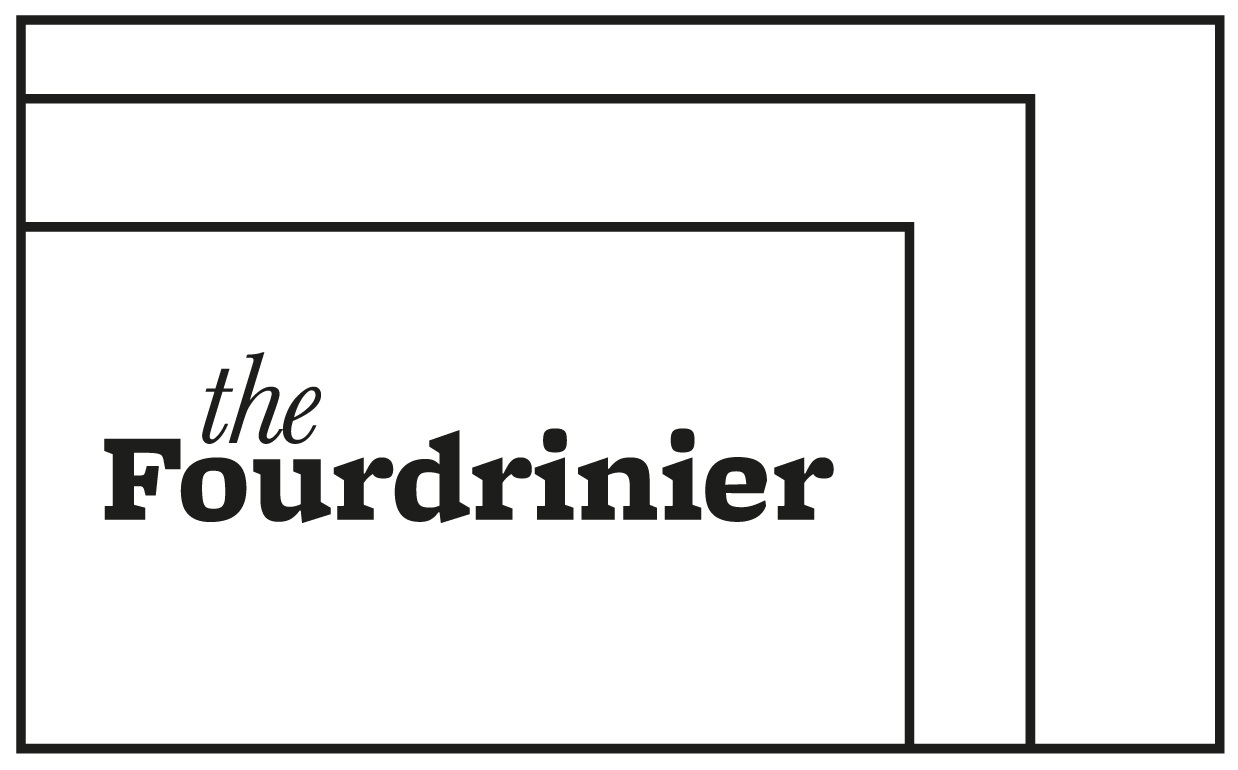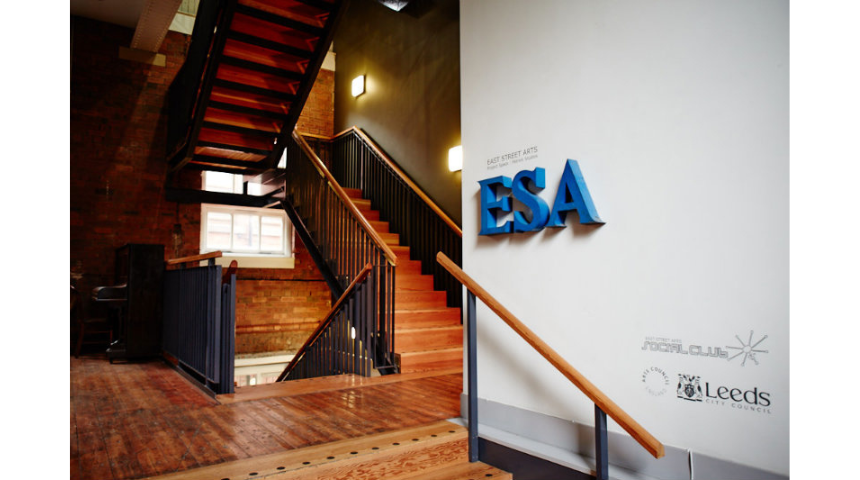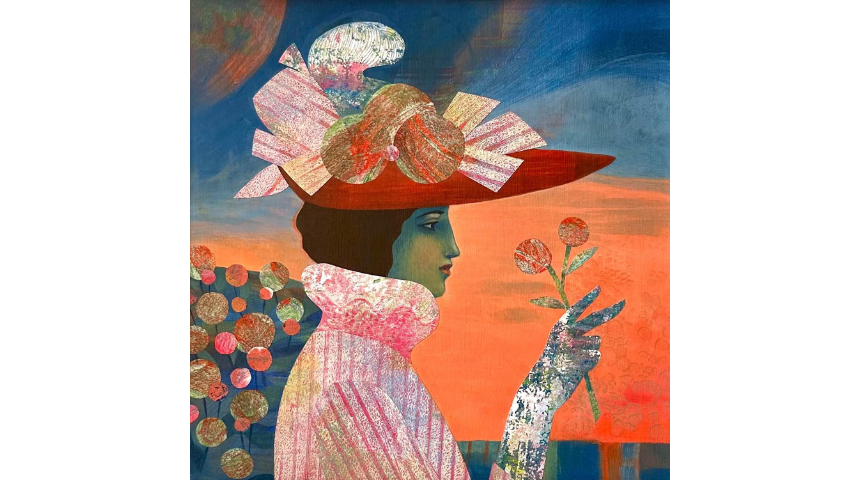FEATURE Sept 2025 East Street Arts Leeds
Charu Vallabhbhai
Entrance of Patrick Studios © East Street Arts
Entranceway of East Street Arts, where wooden floors and a large stairway can be seen to the left, whilst the letters ESA can be seen in blue mounted on the wall on the right-hand side, alongside the Arts Council England and Leeds City Council logos.
Writer and independent curator Charu Vallabhbhai visited East Street Arts in Leeds to learn more about this dynamic creative scene just a stone’s throw away from the busy heart of the city.
11-14 September – East Street Arts Open Studios https://eaststreetarts.org.uk/event/open-studios/
13-14 September – Leeds Open Studios https://leedsopenstudios.com/
Walking from central Leeds towards St Mary’s Street and East Street Arts’ buildings, there are murals and graffiti art that give the sense of entering a district that nurtures and promotes creativity, a place that is home to artists. The structures that support a section of the inner ring-road flyover are adorned with brightly patterned paint forming geometric shapes in colours reminiscent of 1970s décor. The creative hands that designed and produced this are unknown, while the tags left by graffiti artists allude to names recognised by those in the know. Alongside this evidence of urban engagement with visual culture are murals commissioned by East Street Arts who are participating in Leeds Open Studios. The return of Leeds Open Studios to the city this Autumn on the 13-14 September invites the people of west Yorkshire and beyond to meet artists, get behind closed doors of artists’ studios and arts organisations and become fully immersed in a weekend of culture.
East Street Arts, situated in the Mabgate area of Leeds, just a short walk from the Victoria mall where luxury shopping is the offer, is one of the participating organisations, providing the artists who are studio holders opportunity to present their creative outputs. They are also hosting workshop activities, encouraging visitors to get involved, as well as chat, browse and buy.
East Street Arts takes its name from East Street Mills, where Karen Watson and Jon Wakeman, the organisation’s founding directors, leased its 2,000 square foot top floor in order to provide workspace for themselves and other artists. This was in June 1993. Ten years later, the more established charity would move out to a permanent home resulting from the purchase of St Patrick’s Social Club on St Mary’s Lane, Mabgate, in the Bermantofts and Richmond Hill ward of inner-city Leeds. Patrick Studios opened a year later in 2004 and now, twenty-one years on, East Street Arts is firmly established as a resource for artists and the local community. Expanding along the way over the past two decades, East Street Arts also accommodates an adjacent building as an Art Hostel and, opposite, is Convention House.
Convention House is the former site of a convent, now offering artist studio space and temporary work-live space, as well as a technology hub. These late Victorian red brick buildings once served the adjacent Roman Catholic St Patrick’s church that was constructed between 1889 and 1891, with a nunnery, a presbytery for its parish priest and a social club all added, and their construction completed within the first decade of the twentieth century.
The scheme was designed by Leeds architect John Kelly, who specialised in taking commissions for church buildings realised in the Italianate and Gothic Revival styles. St Patrick’s was in use by its parish until moving to new premises in 2001. It was in the 1960s and 70s that the social club, which now forms the heart of East Street Arts’ operation, was an active community hub. This structure was brought to life again as a new bespoke venue for artists, and for founders Watson and Wakeman, this development counted as ‘… the dreams of what East Street Arts could achieve becoming a reality.’
Andi Walker - Anatomy of a Quilt © Jonathan Turner
Three white textile pieces are hung from the ceiling in a large space, each with different dark shapes interwoven into the fabric, made through a process of thawing frozen dye to form new patterns and shapes in the fabric.
In the distance, approaching East Street Arts from the main Leeds shopping area, before turning right to ascend St Mary’s Street is The Black Horse public house, adorned by a mural that pays tribute to the history of this part of the city and its once thriving ceramics industry. The renowned Bermantofts pottery dates to the same period as the building of St Patrick’s church, indicating the rate of construction and development in the Bermantofts area during this period. The pottery produced decorative bricks and tiles in architectural terracotta and later expanded into producing ‘art pottery’, which included vases and decorative domestic items. The important ceramics heritage of Bermantofts resonates with Wakeman and Watson’s own training as makers of ceramics.
This mural, entitled ‘Echoes’, on the wall of the Black Horse pub, was a commission by East Street Arts and was created by Portuguese artist Ad Fuel. It stands out like a jewel, catching the eye in hues of blues and brown. The approach to East Street Arts, continuing uphill towards St Mary’s Lane passes graffiti art, instances of which are creatively crafted. On arrival to the Convention House another mural is situated high up, this time by Mohammed Barrangi. This graceful intermission forms part of a series of three murals, Last Dream, that trace Barrangi’s journey from the area within Leeds in which he lives to East Street Arts, where he is a studio holder. Barrangi’s murals are all made on paper and, like fly-posted art and advertising, they are intended to erode over time, gently fading into their supporting structure and the surrounding city.
Turning the corner of Convention House and following signs for the Art Hostel, another mural adorns its south-east gable end wall. This full-height painting is by Palestinian artist Taqi Spateen, depicting his children imagining a fairy-tale escape from the years of conflict they have been subjected to at home. Described as a ‘permanent residency’ for his children in Leeds, Spateen has transported his children to safety through a route that navigates them away from the gangs that exploit many migrants while exposing them to perilous danger.
Taqi Spateen Mural Launch © Wes Foster / East Street Arts
An image of a large building at East Street Arts, Convention House, with two murals visible in the image. To Be or Not To Be, a mural by Taqi Spateen on the left gable wall, and Theft on the last Monday of the year by Mohammad Barrangi on the right wall.
East Street Arts’ murals are commissioned under their ‘A City Less Grey’ programme strand of large-scale interventions to the Leeds cityscape. Beyond the Burmantofts area there are architectural-size paintings and structures in different areas of the city including Harehills, Kirkstall and Chapeltown. In the heart of Leeds, adorning the ‘Platform’ building, is the UK’s tallest mural. Nomad Clan’s ‘Athena Rising’, another of East Street Arts' commissions, can be viewed daily by thousands of commuters from Leeds train station platforms. Reaching a breadth of diverse audiences for a contemporary painting, the commission can be considered as successful as Gormley’s The Angel of the North, though less controversial and consequently less notorious in the absence of media attention.
The trail of commissions leading up to East Street Arts’ buildings literally act as a trailer, a prelude to what is to be discovered within the walls. A web of histories and narratives dissolve like delicate mesh and merge together, making up the current fabric of the place and contributing to its welcoming ambience. The stories of the buildings and their construction for religious worship and home to its priests and nuns, of the social club in its heyday, East Street Arts’ inception in the Leeds 9 postcode area and the creativity of its founders and artists are all present and visible. This is the visual arts in their broadest definition, demonstrating that visual culture is not merely a niche branch of the arts promoted by commercial galleries for wealthy collectors, nor eye-catching yet predictable marketing. The application of creativity performs an important function in the making of our cities and the communities that form within them in way that is active and inclusive rather than an art-form that is passive and for consumption only.
East Street Arts’ programme has included leading on development and implementation of the neighbourhood plan for the Mabgate, Lincoln Green and Bermantofts area of Leeds, working collaboratively with local residents and organisations to explore what residents want and need in their community. This was done through various activities such as the annual neighbourhood Summer School that collected the voices and perspectives of young people and creative projects including the production of a series of zines, a sound walk and events such as a gift exchange, as well as a seasonal programme.
The Hidden Histories of New Briggate project was a partnership with Leeds City Council and Historic England. The project formed part of the National Heritage Action Zone programme that took place in sixty towns and cities across England. East Street Arts worked with a cultural consortium of seven Leeds based organisations to deliver a three year cultural programme that showcased New Briggate’s rich and diverse heritage. From the outset, East Street Arts commissioned two artists to collaborate in a celebration of past, present and future of the New Briggate area. Through the artists’ creative lens the project brought focus to rich stories of this bustling commercial and cultural high street that forms the gateway to the heart of Leeds city centre.
Teresa Flavin - Aurore. Image Courtesy of the artist.
A mixed media (acrylic and collage elements) painting on wood panel, in which a mysterious woman from the past commands a dramatic sunset-lit world.
Much further beyond St Mary’s Street, East Street Arts’ the Guild and Placemaking projects have focused on supporting and advising artist led groups, collectives and organisations across England in carving out affordable studio spaces and forming a network to share knowledge, innovative practice and information to help artist groups thrive in a sustainable way rather than barely survive. The experience that ESA’s founding directors gained, over decades, in securing space for artists is invaluable when disclosed to other similar groups, particularly considering the extent of what was learned along the way, including adapting to all the changes in funding and practices during those years. With the focus in Guild on collective practice, Placemaking specifically aims to increase workspace provision for artists. Through repurposing buildings and delivering art-focused urban regeneration initiatives, East Street Arts shares their extensive knowledge to help artists and communities recreate value in places of decline.
At home within East Street Arts buildings, reflecting the changing nature of the wider city, artists from elsewhere are welcomed to join the studio holders through its Residency Programme and the Art Hostel. The residency programme offers time, space, facilities and support to artists, enabling them to develop their practice in an exchange which also fosters learning from the visiting artists. The Art Hostel is a unique opportunity for visitors to Leeds to stay in affordable accommodation that has been created by artists. Offering beds for up to 60 guests across twelve rooms, the project is a social enterprise for East Street Arts that helps to build financial stability for the organisation. Described as an opportunity to ‘… sleep in the imagination of the artist…’, Art Hostel shows how art can be engaged with and experienced in a way that removes the boundaries between high and low culture, making it available for anyone looking for a city break. East Street Arts’ eclectic programme strands are consistent in placing artists and communities at the very heart of what they realise. The Open Studios weekend brings to the fore the talent of their studio holders and allows visitors an opportunity to see and experience what goes on behind normally closed doors.
The open studios programme at East Street Arts commences a little earlier than the weekend of Leeds Open Studios with a launch event on Thursday 11 September when Leeds poet Seki Lynch will be performing an evening of poetry accompanied by the soulful jazz sounds of Ozzy Moysey, Hugh Vincent and Mick Bardon from the Ancient Infinity Orchestra. The performance was developed during a residency at East Street Arts and named after Lynch’s debut poetry collection ‘Under the Sun our Hearts are Beating’.
For those interested in hands-on opportunities, on Saturday 13 September Leeds Print Workshop opens its doors allowing access to try out print-making, with drop in letterpress and screen printing as well as the opportunity to book onto a day long workshop in woodcut relief printing. In the afternoon at Convention House artist Georgia Green is running a two-colour Riso workshop on which spaces can be booked.
On both Saturday and Sunday of the weekend, studio holder Gabriella Ranito-Baltazar presents live action painting. Visitors will be encouraged to witness the studio techniques and methods used to create large scale paintings as they develop. On the final afternoon of East Street Arts Open Studios, Dr Frances-Ann Norton will be holding drop-in sessions in religious icon painting. Participants will be guided, step-by step, in traditional Byzantine methods and symbology, in a free workshop where all materials will be provided.
Visit East Street Arts on Leeds Open Studios weekend to be transported into a hidden realm that has been created by artists.
Studio of Andrew Lister © Wes Foster / East Street Arts
An image from Andrew Lister’s studio. A series of wooden-handled tools can be seen on the right, with a work surface visible in the centre, with lettering reading on top of a wooden panel.





